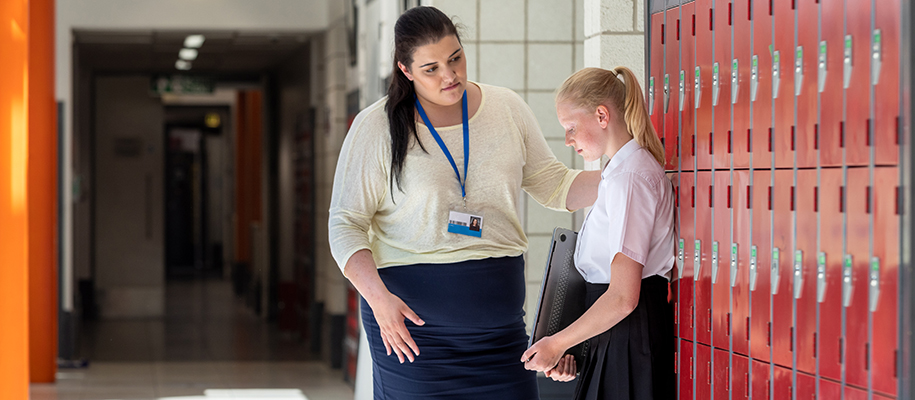Bullying plagues most schools in America and around the world. As a formative time in a teen’s life, high school is rife with insecurities and judgments, both intentional and unintentional. Bullying can cause trauma, perpetuate destructive behaviors, and even lead to fatal consequences. But as an authority figure, there are ways you can proactively look out for bullying and assist students with these difficult situations.
What constitutes bullying?
While most of us are aware of what bullying is, it never hurts to get a refresher so you know what to look out for, even if it seems minor. According to StopBullying.gov and the first federal definition of the word, bullying consists of three core elements:
- Unwanted aggressive behavior
- Observed or perceived power imbalance
- Repetition or high likelihood of repetition of bullying behaviors
After reading these three simple statements, you’ve likely thought of instances when you’ve intervened in this behavior. Even if you’ve dealt with bullies and bullying behavior before, you should never stop trying to improve your crisis intervention skills. As the world continues to adapt, so do the ways bullies target victims and the ways victims react to bullying.
How bullying has changed with technology
It’s important to recognize and be cognizant of how desensitized students have become to mean behavior because of the internet, a constant spread of trends, and group social behavior. If something is part of an online trend or others minimize behavior on a mass scale—as is common on social media—it’s easy for students to brush off bullying and not seek help because they’re led to believe the behavior is normal. Cyberbullying in particular uses these tactics of minimization because, with tone ambiguity over text-based conversations, bullies can easily gaslight victims into believing they’re the ones causing problems.
It’s dangerously easy to take bullying online in a world overridden with technology. Anyone can send life-destroying words in a short text or spread rumors via Instagram stories or popular TikTok trends. According to StopBullying.gov, 15% of students aged 12–18 who reported being bullied during the school year said they were being cyberbullied, either online or by text. This makes it easier for a bully to keep a victim quiet behind the scenes, so no one is the wiser of bad behavior in a public setting like school.
Related: Bullying Prevention: How to Beat the Bystander Effect and Be an Ally
Signs of bullying and steps to combat it
You likely know many of the obvious signs to look out for with students who are victims of bullying, such as:
- Drastic changes in mood from what’s normal for the student
- Self-isolation and inclusiveness
- Symptoms of depression or anxiety
- Missing an unreasonable amount of school
Instead, let’s focus on a couple of areas to be better aware of bullying in the online sphere and things that you’re not seeing but can still do something about.
Keep up with teen slang and trends
The ever-evolving teenage language can seem like a code that’s impossible to crack. While a lot of it is fine to brush off with a cocked eyebrow and a shrug, you should stay updated on the latest slang and viral trends no matter how trivial they may seem. You never know when a new term spreading around school is actually being used to offend and target certain individuals. With the mass spread of TikTok trends and students flocking to social media to keep up with them, it’s also very common for bullies to use a trend as a means of poking fun at someone or spreading rumors under the guise of just having fun and jumping on the bandwagon.
Acknowledge what you’re not seeing outside of school
We know how easy it is for someone to send a text and hurt someone to their core, so it’s important to always keep this in mind and think about what you might not be seeing in person. Bullies are often smart and intentional; they may never target their victim at school and could otherwise present as a model student. The victim, then, may not feel as though they can seek your help if it isn’t happening on school grounds. So how do you provide help when you’re not bearing witness to the act?
Build an environment of trust and support
The first steps are communication and trust. Really get to know the students you work with and check in on them even when you’re not concerned something may be wrong. The more safe opportunities you give them to speak up, the more likely they are to seek your help when they need it most. If a student does open up to you, make sure they feel safe and included in the discussion of the next steps you’ll take to rectify the situation. Don’t feel as though you must take it on alone—bullying behavior is best handled when a community of adults and peers stand together to protect victims, so be proactive in building a network of support for both you and the victim.
Related: How to Guide High School Freshmen Through the Next 4 Years
How to address the bully
When it comes to effective intervention tactics, addressing a bully is often as important as providing direct assistance to the victim. Intervening can sometimes protect that student without halting the bully’s behavior; they may just redirect their aggression from the protected student to a new target, and the cycle continues.
Try to cut the situation off at the source by addressing the bully directly, whether by yourself or with a team of administrators. Bullies will often lash out regardless of your status as an adult mentor or retaliate against their victims even more maliciously when they’re not around. Take the proper precautions and channels to ensure there will be a safe separation between the bully and the victimized student before approaching a bully about their behavior. If you’re concerned about handling the situation alone, come up with a game plan with teachers and other administrators to get both students the help they need.
Understanding but not excusing a bully
Understand the bully? We know that sounds counterintuitive—and it isn’t to excuse behavior or suggest the student who was bullied is any less important or deserving of justice. But bullying is a complex subject, and it often results from many external factors that teachers, peers, or even the bully themselves may not be aware of. In the process of diffusing a harmful situation, it’s important to acknowledge what may have led to the bullying behavior in the first place. Understanding bullying behavior and what leads to it helps us all better combat it in the future when we experience it. It could also potentially get the bully the outside help they need if there’s a larger, more harmful situation at play in their personal lives.
Related: Our Best Advice for Counselors and Consultants to Help Their Students
Being a student and a teenager is hard. We know this is one of the most formative developmental times in anyone’s life, and bullying can have a significant long-term impact on personal success and well-being. Be part of the solution and an ally by constantly striving to improve your awareness and crisis intervention skills for students who may feel like they’re alone.
DYK we have a version of this article for students to help them recognize and combat bullying as well? Share it with them to help put an end to bullying!








